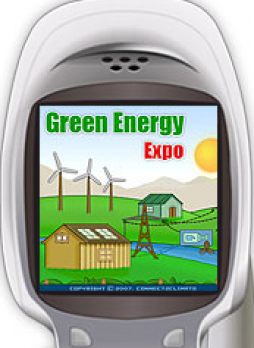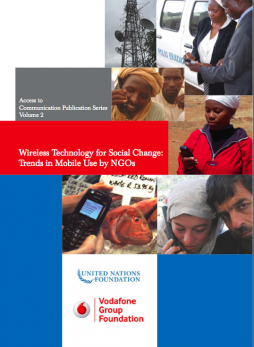environment
Posted by AnneryanHeatwole on Oct 12, 2010
Mobile Telephony as an Enabler of Environmental Action in the Philippines data sheet 1474 Views
Author:
Dolma T. Dongtotsang, Robert A. Sagun
Abstract:
Population growth, economic development and ineffective development policies place the Philippine environment and its natural resources and biodiversity under serious risk. Increased levels of air and water pollution in urban areas, deforestation, soil erosion, coral reef degradation as well as increasing pollution of coastal mangrove swamps important for breeding fish, are some of the threats mentioned by the Philippines Environment Monitor 2004. The situation is made worse by ineffective environmental laws and policies, rapid urbanization, expansion of resource-based markets and the growing apathy of its populace to environmental safeguarding. Environmental degradation is a common global problem, but strategies to halt it must be contextually specific if they are to be effective.
This paper explores how the telecommunications sector, and in particular mobile telephony, offers tools that may be used successfully for environmental action in the Philippines. Our research has indicated the ubiquity of mobile phones in the Philippines; they are convenient, relatively inexpensive, easy to acquire, and can send and receive text messages. For these reasons, using the SMS technology is an ideal and accessible way for the public to take action as well as increase their awareness of environmental issues.
Posted by AnneryanHeatwole on Apr 22, 2010
Today is the 40th anniversary of Earth Day, a global celebration that raises awareness about the enivronment. To do our part to celebrate this day, we’ve put together a look at some of the mobile tools and organizations we’ve covered recently that are doing their part to help the Earth. If you have any suggestions about tools or organizations that are doing great environmental work with mobiles, please leave a comment and let us know – and have a good Earth Day!
Water Quality
We recently covered the Water Quality Reporter, a program in South Africa that uses mobiles to test the health of water supplies. The program allows field workers to use mobile forms or SMSs to cheaply and effectively transfer data about water quality to a centralized database, while receiving feedback about how to handle local water problems.
Posted by AnneryanHeatwole on Oct 08, 2009
Mobile Phones and Development: An Analysis of IDRC-Supported Projects data sheet 2894 Views
Author:
Ahmed T. Rashid, Laurent Elder
Abstract:
In the context of the rapid growth of mobile phone penetration in developing countries, mobile telephony is currently considered to be particularly important for development. Yet, until recently, very little systematic evidence was available that shed light on the developmental impacts of mobile telecommunication.
The Information and Communication Technology for Development (ICT4D) program of the International Development Research Centre (IDRC), Canada, has played a critical role in filling some of the research gaps through its partnerships with several key actors in this area.
The objective of this paper is to evaluate the case of mobile phones as a tool in solving development problems drawing from the evidence of IDRC supported projects. IDRC has supported around 20 projects that cut across several themes such as livelihoods, poverty reduction, health, education, the environment and disasters. The projects will be analyzed by theme in order to provide a thematic overview as well as a comparative analysis of the development role of mobile phones. In exploring the evidence from completed projects as well as the foci of new projects, the paper summarizes and critically assesses the key findings and suggests possible avenues for future research.
Posted by AnneryanHeatwole on Sep 02, 2009
MyCO2Print data sheet 2808 Views
Organization that developed the Tool:
Problem or Need:
Carbon emissions are causing climate change, but tracking one's personal carbon footprint can be difficult. MyCO2Print enables South Africans to measure their carbon footprint in terms of travel and energy use and to try to improve it on a monthly basis.
Brief Description:
The MyCo2Print mobile tool allows WWF SA to run climate and environmental awareness campaigns. MyCO2Print provides users with an approximate rand value of the carbon emissions they are producing. The tool also records users' data and allows for a comparison of results on a monthly basis.
Tool Category:
App resides and runs on a server
Key Features :
- Enables users to access tool via SMS shortcode
- Provides a URL to a WAP site to calculate CO2 footprints
Main Services:
Voting, Data Collection, Surveys, and Polling
Organizations Using the Tool:
- World Wildlife Fund South Africa
Number of Current End Users:
Number of current beneficiaries:
Handsets/devices supported:
Any mobile handset that is WAP enabled or that can access the mobile Internet supports the application.
Is the Tool's Code Available?:
Is an API available to interface with your tool?:
Posted by KatrinVerclas on Apr 22, 2009
Sensing is just one way in which mobiles are used in environmental protection. Another promising area is wildlife protection in sensitive areas where humans and animals collide, often to the detriment of protected animals. In the Laikipia District in Kenya, the University of Cambridge conducted a project using mobile phones to protect and manage Kenya's second largest elephant population, and the ecosystem they inhabit. The goal was to alleviate human-elephant conflict between local farmers and the protected elephants. The project used mobile phones for early warning of elephants approaching farmland by using 'push-to-talk' technologies, and GPS/GSM collars for the elephants, allowing wildlife personnel to intervene before elephant became a danger to farmers and vice versa.
Posted by KatrinVerclas on Apr 21, 2009
If 2009 is the year of the mobile phone for social impact, then Earth Day should mark a special occasion in this regard. More and more organizations and people are discovering how mobile phones can be used for social impact, including how to use mobile tech for environmental protection, sensing, and to leverage just-in-time information to make our movements and actions more environmentally friendly.
An emerging field of research, for example, uses mobiles for "urban sensing," allowing phones to collect scientific data in new and innovative ways. By affixing a sensory device to a mobile phone, mobile sensing provides the opportunity to track dynamic information about environmental impacts and develop maps and understand patterns of human movement, traffic, and air pollution.
A leader in this field is the University of California Los Angeles CENS Lab.
Posted by KatrinVerclas on Nov 20, 2008
The Vodafone Americas Foundation has a new Wireless Innovation Challenge to promote innovation and increase implementation of advanced wireless related technology for a better world. The foundation is providing $600,000 in awards to support projects "of
exceptional promise." The Challenge is open to projects from universities and nonprofit organizations based in the United States.
Projects must demonstrate a multi-disciplinary approach that uses innovation in wireless related technology to address a critical global issue in one or more of the following areas: access to communication, education, economic development, environment, or health. The
technology should have the potential for replication and large scale impact. Teams should have a business plan or a basic framework for financial sustainability and rollout. Submissions deadline is February 2, 2009.
Posted by KatrinVerclas on Sep 11, 2008
We have written a lot about providing consumers with just-in-tine information about products on their mobile. Shoppers can receive an SMS about sustainable fish or climate impact of products already. This is the idea of the new GoodGuide, a new start-up spun out of the University of Berkeley. Good Guide provides 'green' consumer information for shoppers who want to buy products in line with their values.
The brainchild of Dara O'Rourke, an enterprising UC Berkely professor, Good Guide came online yesterday. The 61,000 products already in the database contain hundreds of datapoints. They are organized into three categories: health, social and environmental impact. Currently, there are two product types only: personal care and household chemicals. Food, electronics, toys, and apparel are to be added over the next several months.
Posted by KatrinVerclas on Jun 17, 2008
We have written previously about mobiles as sensing devices to collect data and develop maps and understand patterns of human movement, traffic, air pollution, and even the spread of diseases. The mass-tracking of mobile devices and the use of mobiles as ubiqitous sensing devices are very promising but also have generated controversy, most recently when a Boston University study published in Nature revealed it has tracked 100,000 anonymized mobile phone users' position in an unidentified country (we suspect the UK) without these users' consent.
Posted by CorinneRamey on Jun 02, 2008
Within the next few months, ZMQ Software Systems will be launching new mobile games to educate people about climate change as part of its Connect2Climate initiative. The first three games that ZMQ will release are called Polar Teddy Quiz, Mission Lighting, and DeCarbonator. On their website, ZMQ explains why they choose to use mobile phones for the games:
Posted by CorinneRamey on May 13, 2008
Mobile phones are nothing new for Greenpeace Argentina. The organization has used mobile phones multiple times to mobilize its now 350,000 person-strong mobile list to successfully lobby for important environmental legislation. One of Greenpeace's significant accomplishments was the passage of the Ley de Bosques, or Forest Law.
According to a recently UN/Vodaphone report, Wireless Technology for Social Change: Trends in NGO Mobile Use, before the law was passed forests in Argentina were being quickly destroyed. From the report:
Every hour, trees covering an area the size of forty soccer fields are cleared from the old growth forests of Argentina, home to indigenous tribes and numerous endangered species. According to Greenpeace, 300,000 hectares (3,000 square kilometers or 1,150 square miles) of native forest are cleared in Argentina each year.
Posted by KatrinVerclas on Apr 29, 2008
Mobile technology is transforming the way advocacy, development and relief organizations accomplish their institutional missions. This is nothing new to readers of MobileActive. Our recent report Wireless Technology for Social Change: Trends in NGO Mobile Use, released today by the United Nations Foundation and The Vodafone Group Foundation, brings this point home.
Wireless Technology for Social Change: Trends in NGO Mobile Use was written by Sheila Kinkade (ShareIdeas.org) and Katrin Verclas (MobileActive.org), and commissioned by the United Nations Foundation-Vodafone Group Foundation Technology Partnership. The report examines emerging trends in “mobile activism” by looking at 11 case studies of groups active in the areas of public health, humanitarian assistance and environmental conservation.







